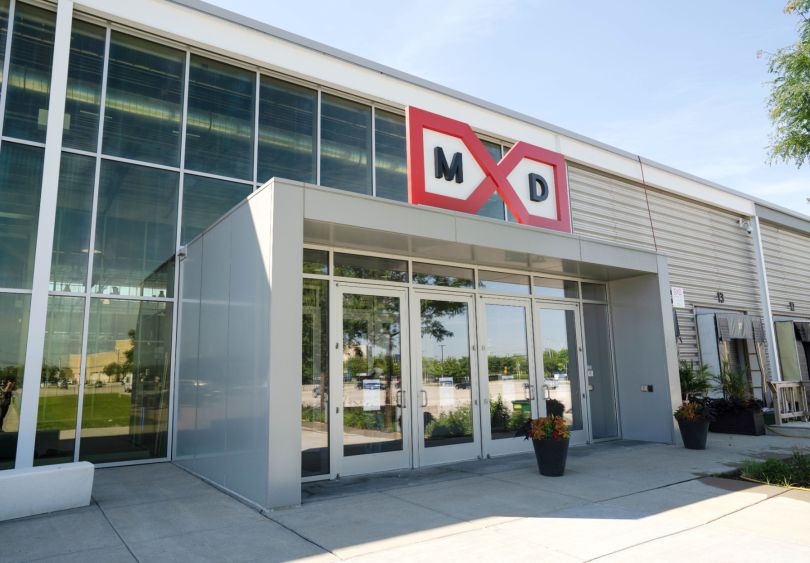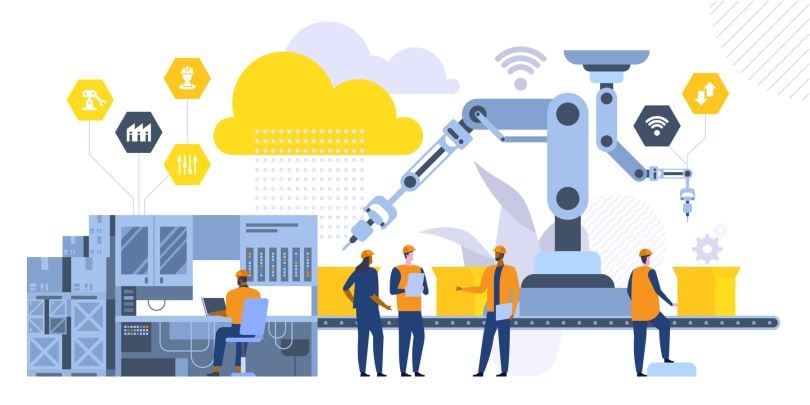Every election cycle seems focused on how to bring long-lost manufacturing jobs back to the United States, but the facts on the ground are a bit more complicated.
A 2018 Urban Institute report shows that the percentage of manufacturing jobs in the workforce has fallen considerably from above 30 percent in 1960 to around 10 percent in 2015, and is also down in terms of the absolute number of jobs from its peak of nearly 20 million in 1980 to 12 million in 2015.
Still, researchers raise concerns that many manufacturing jobs in the U.S. will go unfilled due to a shortage of labor. A study by Deloitte and the Manufacturing Institute in 2018 projected that as many as 2.4 million manufacturing jobs could remain unfilled between 2018 and 2028.
“For a long time, there was sort of this discussion that manufacturing jobs were leaving the U.S., and many were, and so there weren’t many programs in place to train people for manufacturing careers,” said Lizabeth Stuck, senior director at MxD Learn. “And now there is this sort of reshoring that’s happening with manufacturing jobs.”
That’s good news. But because training has lagged, the pipeline of talent for advanced manufacturing jobs, which require more technical training than past manufacturing careers did, is projected to fall short of demand. Initiatives like MxD are trying to find solutions to these problems.
MxD, which stands for Manufacturing times Digital, is part of Manufacturing USA, a network of 14 public–private innovation centers for advanced manufacturing that forms partnerships between government, academia and industry. Started in 2012, and inspired in part by Germany’s Fraunhofer Institutes for applied sciences, the network was created to promote manufacturing innovation in the U.S. and encourage more manufacturing to take place within the country.
The first three innovation centers were planted squarely in the Rust Belt, with locations in Chicago, Detroit and Youngstown, Ohio. Each of the centers in the Manufacturing USA network focuses on one area of expertise.
For MxD, the focus is digital manufacturing, or the use of computer systems in manufacturing. MxD partners with the Department of Defense and with diverse industry partners such as Microsoft, AT&T and Dow Chemical — companies that work in manufacturing in different ways.

No Workers, No Factories
When companies expand their sites and plan for where to locate manufacturing facilities, they sometimes have trouble picking locations because of what they see as a lack of the right skills in the labor pool, Stuck said.
“We’re working with a region in the Midwest, and they just had a problem where a large manufacturer came and said it’d like to put a facility here,” Stuck said. “They went through the whole process and they determined that they couldn’t because there weren’t enough workers in that region to support their operation. And so now that region is looking to work with us to create some curriculum programs for young people so that when an opportunity like that comes up again, they are prepared.”
Some of this is because modern manufacturing jobs are different from what manufacturing looked like in the 1960s.
“Manufacturing really isn’t standing at an assembly line and doing ‘picker packer’ — where you’re pulling things off and putting them in boxes and shipping them off,” Stuck said. “It’s a lot more about interfacing with technology.”
Although automation displaced many factory workers, the demand for people who can use technology effectively to help run a manufacturing facility has not been filled.
“It’s hard for academia to know what kind of curriculum they should be building and what kind of training should be happening.”
“Somebody has to be designing the robot to do what they’re supposed to be doing on that assembly line, managing them, doing the maintenance,” Stuck said. “The new technology in place that can be applied to manufacturing has opened up this whole new world of career opportunity.”
But even people within the manufacturing sector say it’s difficult to know what skills best equip students for a successful future in the new manufacturing landscape.
“It’s hard for academia to know what kind of curriculum they should be building and what kind of training should be happening,” Stuck said. “Even current workers who may be early in their careers, who expect to do this for a long time — what kind of skills do they need in order to continue being a valuable part of that organization?”
MxD partners with community colleges around the country to prepare students with timely skills. MxD also works with traditional engineering schools, but the curriculum at engineering schools don’t line up perfectly with the skills required for jobs in manufacturing, and attending can be a significant investment.
“[Community colleges] are another underutilized asset in terms of skill development for manufacturing careers,” Stuck said. “They’re relatively agile in their ability to stand up your programs and run them. There’s so much need — it really couldn’t have too many academic institutions working together.”
There’s also a perception challenge when it comes to manufacturing careers. Teachers, guidance counselors and parents don’t think of manufacturing when advising students on their possible career choices.
“It is not always seen as either a lucrative career or an exciting career,” Stuck said. “It’s not something young people say they aspire to very often.”
A 2019 report by MxD found that the average annual compensation for manufacturing is $73,000, and $95,000 for advanced manufacturing. Positions in advanced manufacturing range from those that work primarily with computers and models — such as “digital twin architects” who use computer models to optimize manufacturing systems — to “worker experience designers” that help design manufacturing spaces to be safe and effective, and many other roles in between.

Manufacturing Cybersecurity Is Growing Too
As manufacturing floors take advantage of technological innovations and grow increasingly digitized, there are also more opportunities for cyberattacks. In 2019, MxD was designated as the National Center for Cybersecurity in Manufacturing by the Department of Defense. This means that MxD does a lot of work around cybersecurity as it applies to the specific needs of manufacturing.
“At the same time as [companies] may be increasing their efficiency and effectiveness, they also increase their vulnerability to a cyberattack,” Stuck said.
The objective of attackers when conducting manufacturing cyberattacks is different from other types of attacks. People mostly hear about incidents that target companies with consumer information, such as credit card numbers or social security numbers, which attackers can use or sell to other parties. But cyberattacks against manufacturers target access to industrial knowledge.
“They’re not opportunistic,” Stuck said. “These are really targeted attacks, typically going after the supply chain of larger manufacturers. They’re usually pretty highly coordinated and they have a very specific purpose in mind.”
Attacks could target the supply chain, or research and development, or the compliance and legal departments. And manufacturers are becoming easier targets, Stuck said, because of their “increasingly connected manufacturing floors.”
“Attacks can be done where you’re able to get access to designs that you can then replicate, so you could be making a part the exact same way a competitor is without them knowing it,” Stuck said.
Stealing designs would allow attackers to benefit from improvements without needing to invest in their development, and therefore be able to produce parts at a lower cost.
“At the same time as [companies] may be increasing their efficiency and effectiveness, they also increase their vulnerability to a cyberattack.”
But there are also security reasons for preventing cyberattacks against manufacturing facilities. Attacks could pose risks not only to individuals working in plants, but also to consumers who use the products they manufacture.
“You could really have malintent, making faulty parts,” Stuck said. “And while maybe the mom-and-pop shop that you have is just making a bolt, if that bolt is attaching to a screw that holds on the wing of an airplane, it can become very important.”
MxD has workforce programs that support skill development in the areas of digital manufacturing and cybersecurity in manufacturing. Last month, it announced that it was developing a digital training program for cybersecurity in manufacturing, in partnership with the University of Maryland–Baltimore County, geared for workers in manufacturing.
“A lot of manufacturers, they don’t have people within their organization who understand cybersecurity for manufacturing and how to protect themselves, and what they need to do to make sure that they are securing their manufacturing plants,” Stuck said.
The course covers the fundamentals of cybersecurity in manufacturing, touching on topics such as risk management, compliance requirements, secure network analysis and some computer basics.
“Manufacturers need to be adopting these advanced technologies and digital technologies, it’s really the only way to be competitive,” Stuck said. “But you also have to be looking for security at the same time.”




